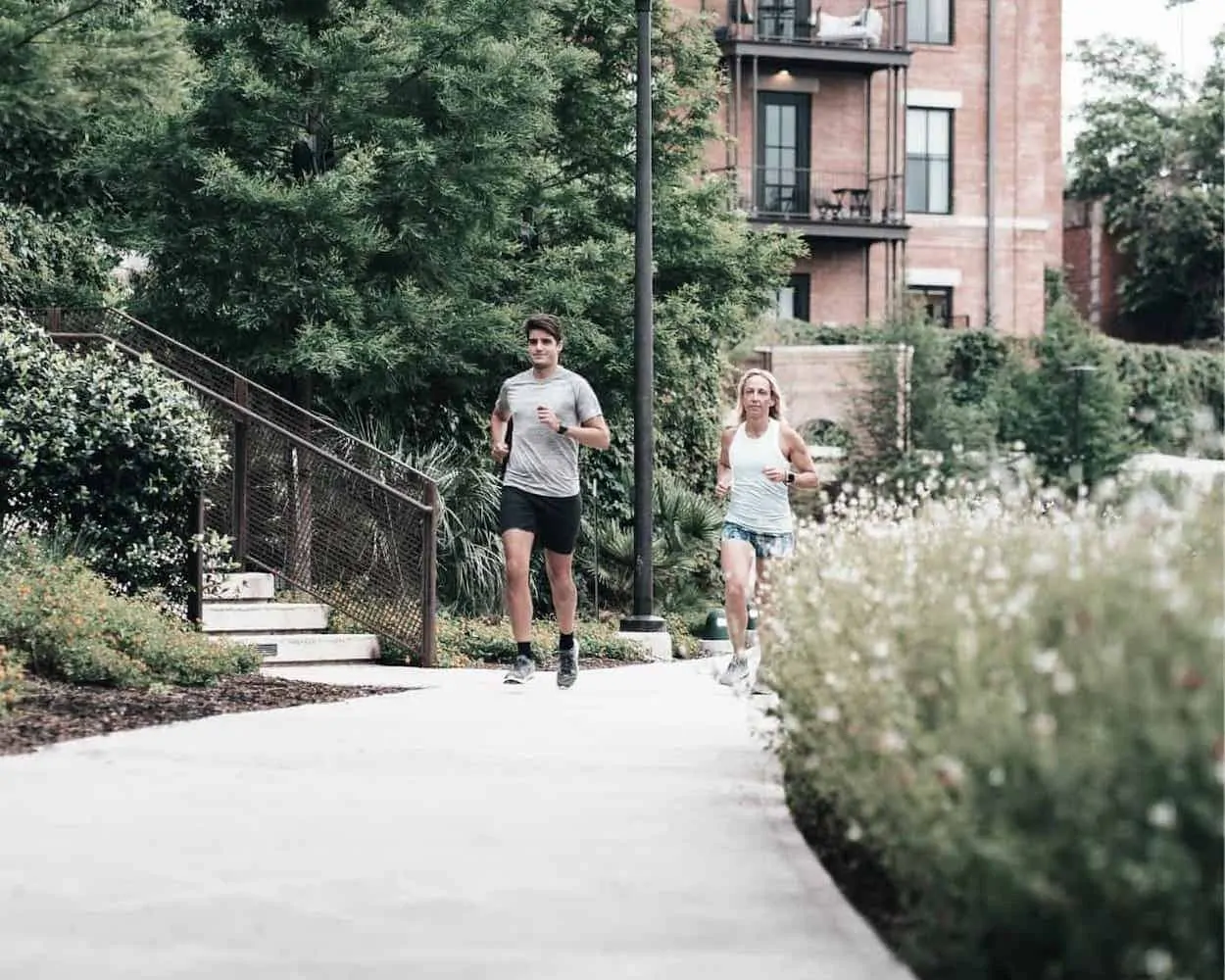Walking for self-care
One of the simplest methods to improve mental and physical health is walking. We discuss the benefits of walking plus share a guide on how to walk for self care.
One of the defining characteristics of a minimalist is someone who is keen on finding the simplest path to reaching a particular goal. When it comes to self-care there is probably no easier habit to adopt than the form of exercise that is walking.
You have to do it anyway to get from A to B so why not approach it more mindfully in order to reap greater benefits? In this guide we break down the benefits of walking and how to walk for weight loss and general self-care.
Develop a Healthy Self-Care Routine
Managing your wellness can be confusing and overwhelming, our simple yet holistic guide to self-care can help.
How Important Is Walking
One of the biggest contributors to preventable mental and physical diseases (like obesity) is a sedentary lifestyle. In the U.S. alone, people spend 90% of time sitting inside and this is responsible for 3 million annual deaths.
Scientific research stresses how important it is to overcome a sedentary lifestyle as a key preventive measure against top diseases and illnesses.
Physical activity was ingrained in our ancestors’ lifestyle as they had no alternative in order to nourish and protect themselves — it was a necessity. Though in modern times, being active is not directly linked to short-term survival for most people, so we sit and sit and use our brains more than our bodies.
However, movement has a broad-reaching impact on your overall health including helping the brain work at optimal capacity, reducing risk of diseases, and normalizing hormones and chemicals in the body.
Establishing a walking routine that works best for you and your fitness level is an effortless way to overcome a sedentary lifestyle and improve your health.
21 benefits of walking
If you think something as simple as taking a walk couldn’t possibly benefit you in any significant way, think again. Because it is so easy, it’s easy to disregard. When it comes to wellness it seems the general trend is towards intensity and complexity.
So, to prove just how beneficial a mere walking routine can be, we’ve compiled a comprehensive list of ways walking can improve your health and wellness. In no particular order, here are 21 benefits of walking:
1. Boost brainfood — walking has a whole host of benefits for your brain including cognitive functioning and memory improvement, according to a study published in the Journal of Developmental Neurorehabilitation.
2. Prevent disease — walking is promoted by the American Heart Association, the American Cancer Society, and Mayo Clinic as a great way to reduce your risk of numerous medical diseases like cancer, diabetes, high blood pressure, high blood sugar, type 2 diabetes, and heart disease.
3. Manage depression — a study published in the Archives of Internal Medicine showed that depression sufferers who walked daily improved symptoms as much as people who took medication.
4. Lose weight — In addition to walking being a great way to burn calories and burn body fat, which contributes directly to weight loss, Harvard researchers found that brisk walking for an hour reduces the effects of 32 obesity-promoting genes by 50 percent.
5. Lighten mood — a study in PubMed Central found that walking improves your mood, boosts self-esteem and encourages social interaction.
6. Aid circulation — to get your heart pumping, improve circulation, and lower blood pressure, WebMD recommends moderate aerobic exercises like walking that enable you to move more and take in more oxygen.
7. Sleep better — a large study published in Science Direct found that those with a regular brisk walking routine improved their sleep hygiene and achieve better and longer sleep.
8. Ease pain — research presented at the American Academy of Pain Medicine found that moderate activity like walking can substantially reduce chronic pain.
9. Breathe better — proper breathing techniques combined with walking (also known as “breathwalk”) are a powerful wellness duo, according to several studies such as one published in the World Journal of Gastroenterology.

10. Alleviate allergies — a study published in the Journal of Annals of Allergy, Asthma & Immunology showed that walking moves allergens through the body, significantly reducing the impact of allergy symptoms such as sneezing and running nose.
11. Improve relationships — walking with friends and family is a wonderful way to connect while getting a workout in. A study in the Psychology of Sport and Exercise journal found that when you walk it sets a positive example and motivates loved ones to walk too.

12. Speed digestion — according to researchers at the University Hospital of Heidelberg at Mannheim, walking after a meal aids the rate that food moves through the stomach, aiding digestion, and decreasing blood sugar (which also decreases cardiovascular risk).
13. Stimulate creativity — a study published in Frontiers in Neuroscience suggests that walking leads to stimulation in parts of the brain associated with creative thinking.
14. Decrease stress — the American Journal of Cardiology contains a study that suggests regular walking creates a dose response eliminating cortisol (the stress hormone) from your system, thus reducing worry and anxiety.
15. Strengthen bones — an Oxford Journal study determined that leisure exercise kept bones strong and healthy, helping to prevent issues such as osteoporosis as you age.
16. Age gracefully — a study published in the Public Library of Science suggests that just moderately exercising can increase your life expectancy by seven years.
17. Brighten skin — research in the PLOS ONE journal found that moderate exercise like walking impacts DNA in a way that makes you younger on a cellular level (and makes you look younger too). So add walking to your skin care routine.
18. Improve metabolism — a study published in the Circulation scientific journal states that brisk, high-intensity walking can boost your metabolism.
19. Increase happiness — according to Penn State researchers, people who are physically active feel more excited and enthusiastic than those who aren’t.

20. Better vision — research published in the Journal of Neuroscience links regular exercise with healthier eyeballs and reduced risk of vision loss.
21. Save money — discussing what one gains from walking that is not medical, what’s most awesome about walking is that you don’t need a treadmill, fancy equipment, or expensive gym membership to get started. Simply get up and get moving.
How to walk for health
Though walking is an easy and cost-effective way to reap all the aforementioned benefits like weight loss and brain health, here are a few tips to enhance your routine.

Allocate time
A 10-second walk from your desk to the refrigerator doesn’t technically count as a walking routine. If you want to lose weight and see other significant health benefits, you need to build a daily routine around it.
Health.gov’s physical activity guidelines recommend a minimum of 30 minutes of moderate exercise every day or approximately 10,000 steps.
Walk briskly
The second point is to make sure your walking routine is moderate intensity. Though a walk such as long leisurely stroll counts, you are more likely to rev up your heart, burn calories, burn fat, strengthen muscle and trigger a whole host of other advantages with aerobic-style fitness exercise.
As it pertains to walking, this mean brisk or alternating intervals of slow and fast speeds. You may also upgrade your routine by occasionally opting for a hike or light jog.
Perfect your posture
Your posture, including your step and stride, contribute to your ability to walk with energy and speed, which is the aerobic style that yields more benefits.
Proper walking techniques also reduce any risk of injury and relieves associated aches and pains. The Mayo Clinic created a useful visual guide outlining the proper walking techniques to follow.
Setting the pace
As it pertains to walking, this mean brisk or alternating intervals of slow and fast speeds. You may also upgrade your fitness routine by occasionally opting for a hike or light jog. You do not need a treadmill to experiment with adjusting the pace in which you walk to complement your fitness level and every day needs.
Get good walking shoes
As mentioned, no need to spend a fortune purchasing high tech gear as walking is a physical activity that simply doesn’t command all of that. Our only recommendation is that you invest in a decent pair of high-quality walking sneakers to provide ankle and arch support during your walks every day.
There are tons of recommendations on the best walking shoes available, but ultimately it’s a personal decision that will come down to trying on a few pairs.
The two brands that top the charts for just about any ranking on walking shoes are Asics and New Balance. Both of their websites offer shoe finders, good search filters and a wealth of additional resources to help you find the right pair of sneakers for you. If you are interested in a more natural stride, Altra is a brand that provides zero drop (from the heel to the forefoot) and a wider toe box to give your feet room to walk naturally.
Use an app to track your walking
To stay motivated and track progress, which are important for establishing a habit around walking, try using a pedometer app. Two apps our team uses are:
Take the Self-Care Challenge
Take the confusion and complexity out of managing your well-being with this simple yet holistic health and wellness program.
Go out and get walking
You do not need to buy a treadmill and get those muscles moving, just get outside and start going on walks.

What just 30 minutes a day can do
Physical activity such as going on walks can be very advantageous for everyone, men, women, whatever your gender. Implementing these healthy habits for at least 30 minutes can improve your life in various areas.
This can include improving your sleep schedule, your mental health and happiness, your fitness levels, strengthening that muscle, and a host of other benefits all throughout your body and mind.
Remember this is your workout
A walk is a great physical activity no matter what your fitness levels are, start off aiming to walk a couple days per week. Set the pace where you feel comfortable and go from there, keeping that heart rate up as long and as strong as possible.
Walking inspiration
For a bit of additional motivation to encourage your walking habit, we’ll leave you with a passage by Henry David Thoreau, from his book Walking.
I think that I cannot preserve my health and spirits, unless I spend four hours a day at least — and it is commonly more than that — sauntering through the woods and over the hills and fields, absolutely free from all worldly engagements. You may safely say, a penny for your thoughts, or a thousand pounds.
When sometimes I am reminded that the mechanics and shopkeepers stay in their shops not only all the forenoon, but all the afternoon too, sitting with crossed legs, so many of them — as if the legs were made to sit upon, and not to stand or walk upon — I think that they deserve some credit for not having all committed suicide long ago.
I, who cannot stay in my chamber for a single day without acquiring some rust, and when sometimes I have stolen forth for a walk at the eleventh hour, or four o’clock in the afternoon, too late to redeem the day, when the shades of night were already beginning to be mingled with the daylight, have felt as if I had committed some sin to be atoned for, — I confess that I am astonished at the power of endurance, to say nothing of the moral insensibility, of my neighbors who confine themselves to shops and offices the whole day for weeks and months, aye, and years almost together.
I know not what manner of stuff they are of — sitting there now at three o’clock in the afternoon, as if it were three o’clock in the morning. Bonaparte may talk of the three-o’clock-in-the-morning courage, but it is nothing to the courage which can sit down cheerfully at this hour in the afternoon over against one’s self whom you have known all the morning, to starve out a garrison to whom you are bound by such strong ties of sympathy.
I wonder that about this time, or say between four and five o’clock in the afternoon, too late for the morning papers and too early for the evening ones, there is not a general explosion heard up and down the street, scattering a legion of antiquated and house-bred notions and whims to the four winds for an airing-and so the evil cure itself.
Affiliate Disclosure: As an Amazon Associate, Minimalism Co earns from qualifying purchases.
Minimalism Co also participates in other affiliate marketing programs that may pay a commission to Minimalism Co without affecting the price a customer pays.